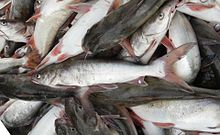| Manila sea catfish | |
|---|---|

| |
| Conservation status | |
 Data Deficient (IUCN 3.1) | |
| Scientific classification | |
| Domain: | Eukaryota |
| Kingdom: | Animalia |
| Phylum: | Chordata |
| Class: | Actinopterygii |
| Order: | Siluriformes |
| Family: | Ariidae |
| Genus: | Arius |
| Species: | A. manillensis |
| Binomial name | |
| Arius manillensis Valenciennes in Cuvier & Valenciennes, 1840 | |
| Synonyms | |
| |
Arius manillensis is a species of marine catfish endemic to the island of Luzon, Philippines. It is commonly known as the sea catfish, Manila sea catfish or kanduli. It is fished commercially.
Taxonomy and nomenclature
Arius manillensis was first described by the French zoologist Achille Valenciennes in 1840. It belongs to the subfamily Ariinae of the family Ariidae (ariid or fork-tailed catfishes).
It should not be confused with the closely related Cephalocassis manillensis, also described by Valenciennes in 1840.
Other common names of the species include kandule, dupit, kiti-kiti, tabangongo, and tauti.
Description
Arius manillensis reach a maximum standard length of 29.6 cm (11.7 in) (in males).
Distribution and habitat
Arius manillensis is endemic to the island of Luzon, Philippines. It is found in the area around Manila, Bataan, Laguna, Cavite, and Rizal; including the Pasig River and Laguna de Bay. It inhabits marine, brackish, freshwater, and benthopelagic habitats.
Biology
Arius manillensis are mouthbrooders. The males of the species incubate the eggs within their mouths for six to eight weeks and provide shelter for the young once they hatch. A single instance of a female carrying eggs in her mouth has also been reported. Upon hatching, the young forage for plankton in short bursts but will quickly return to the safety of the mouth of the adult if alarmed. They eventually become independent once they reach a size of 30 to 44 mm (1.2 to 1.7 in). During the entire period, the adults do not eat and their stomachs shrink dramatically.
References
- ^ Torres, A.G.; Leander, N.J.S.; Kesner-Reyes, K. (2022). "Arius manillensis". IUCN Red List of Threatened Species. 2022: e.T196798A2476461. doi:10.2305/IUCN.UK.2022-1.RLTS.T196798A2476461.en. Retrieved 21 March 2024.
- ^ Alexandre P. Marceniuk & Naércio A. Menezes (2007). "Systematics of the family Ariidae (Ostariophysi, Siluriformes), with a redefinition of the genera". Zootaxa. 1416: 1–126. doi:10.11646/zootaxa.1416.1.1.
- ^ Froese, Rainer; Pauly, Daniel (eds.). "Arius manillensis". FishBase. February 2024 version.
- ^ James Richard Arthur & Susan Lumanlan-Mayo (1997). Checklist of the parasites of fishes of the Philippines. FAO Fisheries Technical Paper. Fish Health Section of the Asian Fisheries Society, Food & Agriculture Organization of the United Nations. p. 57. ISBN 978-92-5-104036-2. ISSN 0429-9345.
- P. Arturo Acero & Ricardo Betancur-R. (2007). "Monophyly, affinities, and subfamilial clades of sea catfishes (Siluriformes: Ariidae)" (PDF). Ichthyological Exploration of Freshwaters. 18 (2): 133–143.
- ^ "Endemic Philippine Marine Fish Species". OneOcean, USAID. Retrieved January 5, 2012.
- Jose V. Yapchiongco (1963). "Spawning habits of the murrell or snakehead fish, Ophicephalus striatus Bloch". Proceedings of the Linnean Society of New South Wales. 1963 (4): 700–702. doi:10.2307/1440975. JSTOR 1440975.
- Manuel Mendoza Carranza & Arlette Hernández Franyutt (2005). "Annual reproductive cycle of gafftopsail catfish, Bagre marinus (Ariidae) in a tropical coastal environment in the Gulf of Mexico" (PDF). Hidrobiológica. 15 (3): 275–282.
- M.A. Rimmer & J.R. Merrick (1982). "A review of reproduction and development in the fork-tailed catfishes (Ariidae)". Proceedings of the Linnean Society of New South Wales. 107 (1): 41–50.